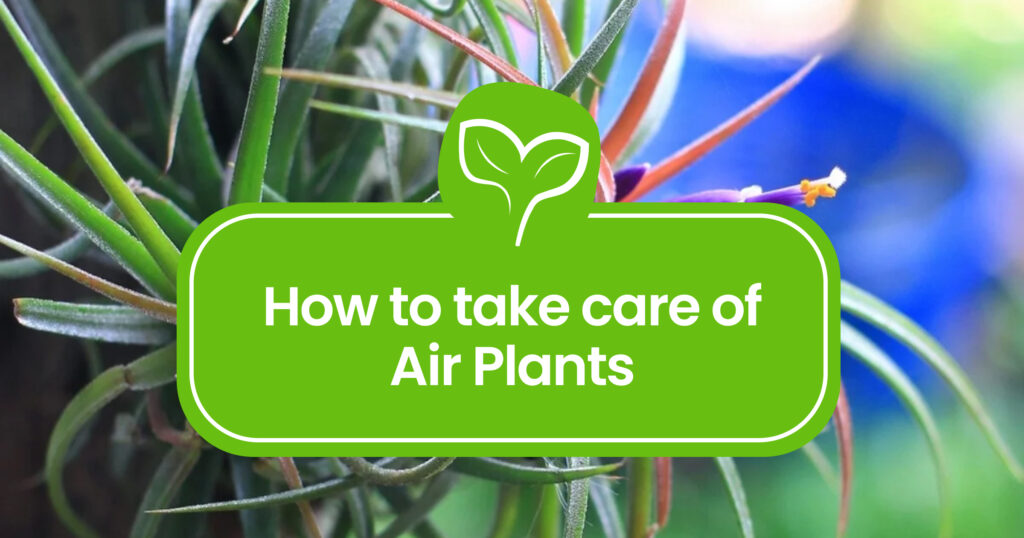
Ready to dive into the fascinating world of Air Plants (Tillandsia spp)? These little wonders might not need soil, but they sure do need a whole lot of TLC. In this guide, we’ll discuss everything you need to know about how to take care of Air Plants.
We are going to cover
- Their watering, light, and temperature needs
- See if you should trim your air plants or not
- How to handle Air Plant pests
- Variety specific Air plant tips
Quick tips to keep your Air Plant happy
- Misting them regularly is basically a must. In a steamy bathroom or a kitchen, they’re pretty happy, but in drier spots, you need to do the misting yourself.
- Choose a warm, bright spot in your home where your air plants can bask without getting a sunburn. Indirect or filtered sunlight is the way to go here.
- Air plants are very adaptable plants, so they’re okay with room temperatures that range from 50°F to 90°F (10°C to 32°C).
- Keep an eye out for mealybugs. Combat them by giving your plant a gentle rinse under the faucet, or a quick bath in soapy water can do the trick.
How to Care for Air Plants
Watering
Let’s talk about hydration in more detail. Keeping your air plants hydrated is vital since they don’t chill in soil. They rely on misty rain for water and nutrients. Misting them regularly is basically a must. In a steamy bathroom or a kitchen, they’re usually doing great, but in drier spots, you need to do the misting yourself.
You can choose to mist, soak, or dunk them. Misting is just spraying leaves, soaking is a 20-30 min bath, while dunking means a quick dip. Watering rhythm varies – species, surroundings, and seasons play a part. Generally, it’s at least once per week.
But remember, Air plants need clean air also, so make sure that after watering or misting, they get enough air movement as well. Do not place them under the A/C!
Do Air Plants Need Soil?
Most of the time, you can leave that potting soil in the shed. Air plants are more into a free-spirited, soil-free lifestyle. They anchor themselves to trees, rocks, and even telephone wires in the wild. At home, you can pop them into a cute container or display them on shells, driftwood, or any creative vessel your heart desires.
Some varieties can also do okay in arid, well-draining soil mixtures.
Light
A warm, bright spot in your home where your air plants can bask without getting a sunburn. Indirect or filtered sunlight is the way to go. A bit of morning sunshine or a cozy spot near a window with sheer curtains will keep these beauties happy. Avoid placing them in harsh, blazing sunspots – their leaves can get burnt very easily.
Temperatures
Air plants are very adaptable plants. They’re okay with room temperatures that range from 50°F to 90°F (10°C to 32°C). Just remember, they’re tropical at heart, so avoid exposing them to frosty drafts or sudden temperature shocks. A cozy indoor spot is where they feel all warm and fuzzy.
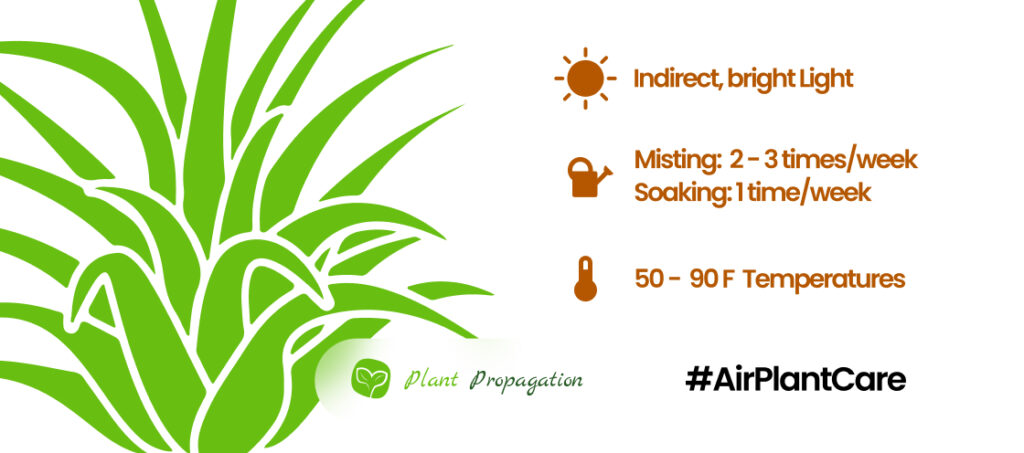
How to take care of an air plant – Should you Trim it?
Pruning is a prudent practice for air plant aficionados. Removing withered and browned leaves creates space for new growth. Delicate trims to eliminate dried leaf tips, damaged foliage, and spent blooms encourage the plant’s vitality. While the option to excise roots exists, rest assured, that this step won’t inflict harm upon the plant.
Additionally, the decision to separate air plant offsets, or “pups,” can be exercised once they’ve achieved sufficient maturity. Remember, prudent pruning promotes prospering plants.
Battling Pests and Diseases
Keep an eye out for mealybugs or aphids, those unwelcome guests that might occasionally show up around your Air Plant. Combat them by giving your plant a gentle rinse under the faucet, or if things are getting intense, a quick bath in soapy water can do the trick. Just remember to rinse thoroughly and give your air plant some time to dry off.
As for diseases, air plants are pretty tough ones. They can occasionally get brown spots from overwatering or being too much in humid conditions. Prevention is the key, so make sure they have good air circulation and aren’t sitting in moisture for too long. If you do spot a few spots, you can trim them off and adjust your care routine.
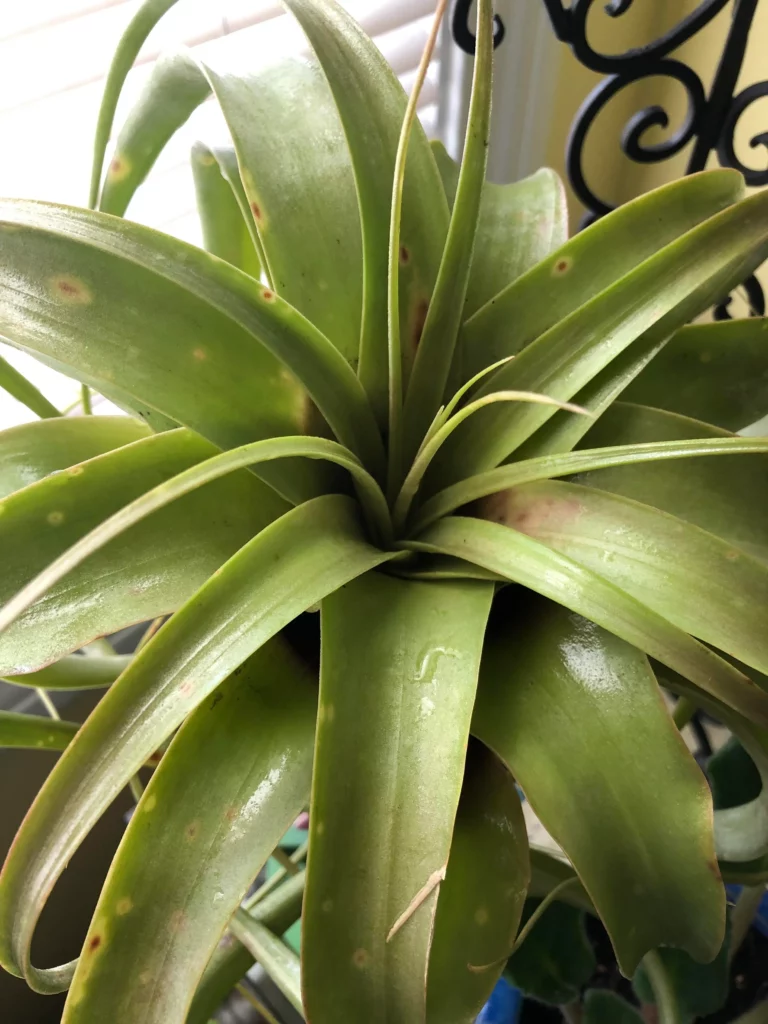
Propagating Air Plants
There are two easy ways to propagate Air Plants yourself. You can do it by division or by using cuttings.
Propagate Air plants by Division
- Gently wiggle or use a clean knife/scissors to separate pups from the plant base.
- Shower love on your newbies just like the original.
Propagate Air plants by Cuttings
- Snip 4-5 inch cuttings.
- Let them rest for 24 hours.
- Dip ’em in water and bask in bright light.
- Refresh their water weekly. Watch as roots appear.
Varieties of Air Plants
Air plants come in a jaw-dropping variety of shapes and sizes. Whether you’re into the elegance of a single air plant or the drama of a clustered arrangement, there’s an air plant variety that’ll make your heart skip a beat. Let’s take a look at some of the most popular ones and what you should pay attention to when caring for them!
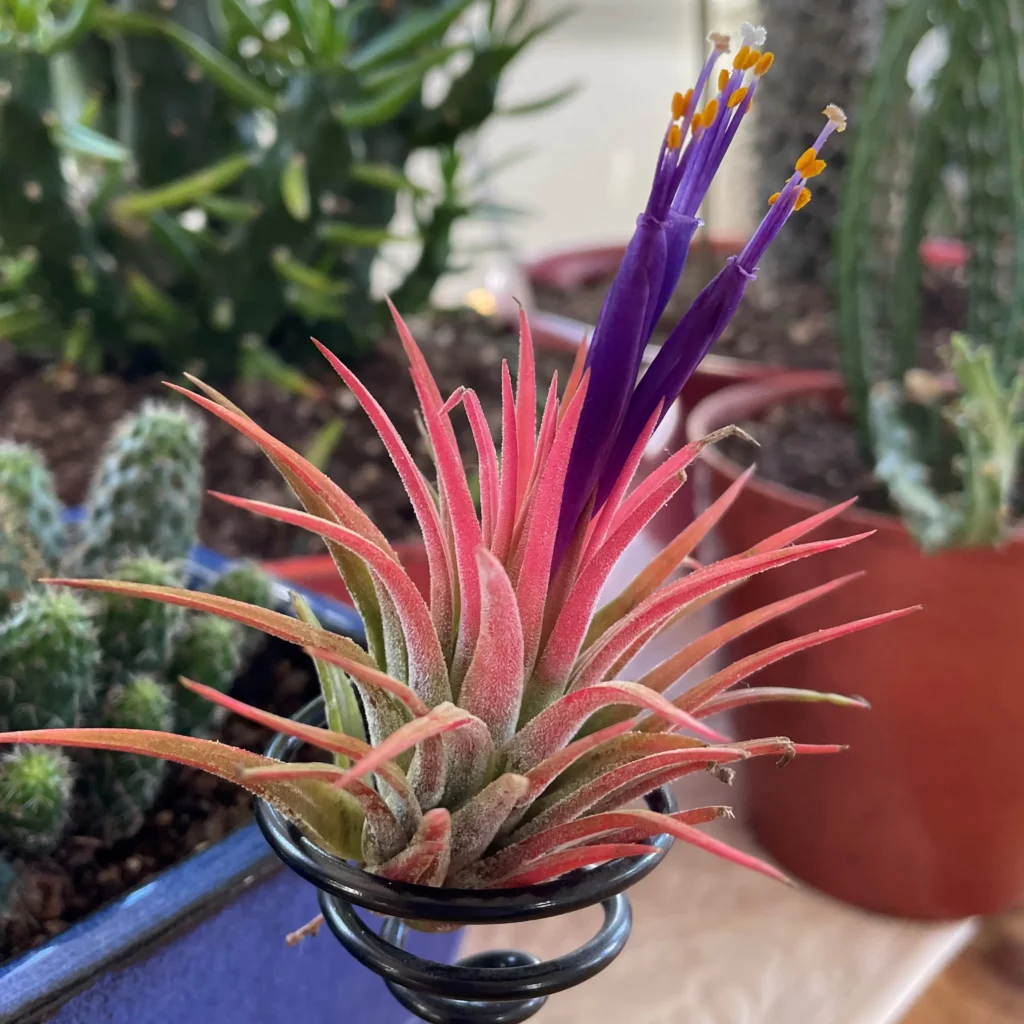
Tillandsia Ionantha
Also known as the “sky plant”, a superstar in the air plant world. With various ionantha varieties, this little gem starts with silver-green leaves, but its real show begins during its bloom cycle. Watch as the leaves blush into reds and pinks, leading to a sunny yellow flower. This tropical native from South America and Mexico is like the tough sibling of air plants. It’s cool with indirect light and won’t fuss about weekly or bi-weekly soaks.
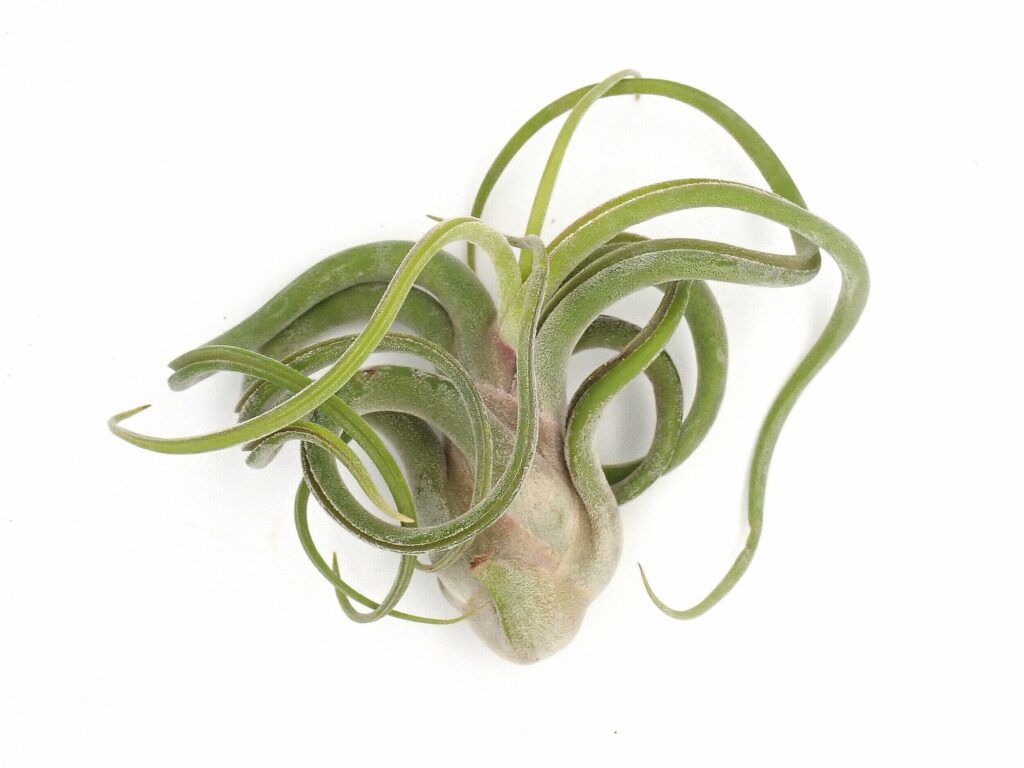
Tillandsia Caput-Medusae
The Tillandsia caput-medusae, aka the head of Medusa, breaks the rules with its unruly looks. Its leaves wave like the snakes on Medusa’s head, and the silver-green fuzziness is just the beginning. Hailing from Central America and Mexico, this xeric plant can handle the dry and sunny life like a champ.
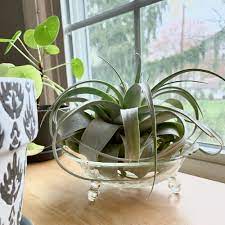
Tillandsia Xerographica
Tillandsia xerographica, or xeros, comes from the treetops of Mexico, El Salvador, and Guatemala. With its spherical shape and slow growth, it’s a true lesson in patience. Tolerating drought like a champ while teasing you with the promise of a striking red or yellow flower.
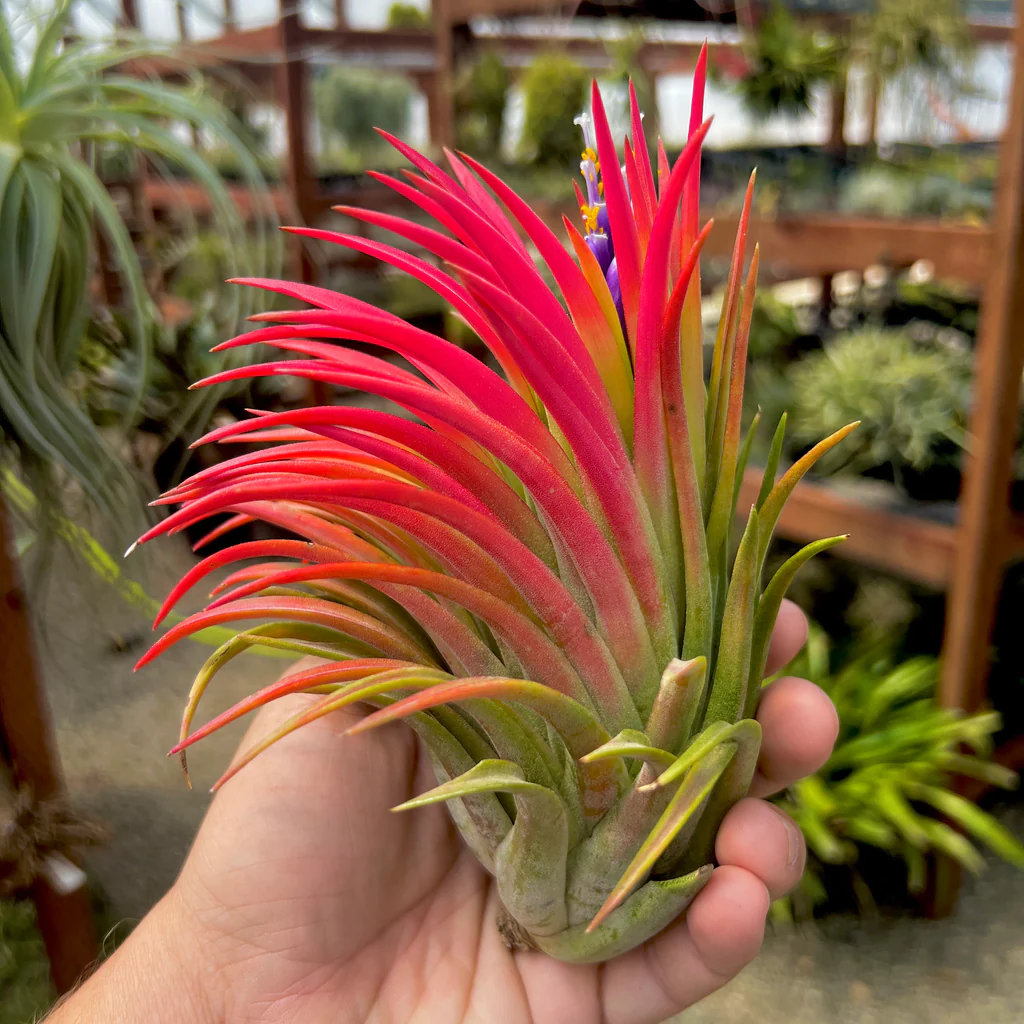
Tillandsia Ionantha Maxima
The Tillandsia maxima from Mexico’s Oaxaca region is the grand show-off of ionanthas. Its green leaves burst into coral before flaunting a deep purple flower. This variety likes its sun and heat, growing larger than most ionanthas. Plus, it’s a multitasker, sporting multiple flowers at once.

Tillandsia Cyanea
The Tillandsia cyanea, or pink quill, is the wild card with its pink quill-like foliage and violet blooms. It’s a rebel too – it can grow in soil or air. Native to Ecuador’s rainforests, this plant prefers misting over soil and boasts a unique way of nutrient absorption through its leaves.
Frequently Asked Questions
The details depend on the variety, but here are our tips that you can’t go wrong with:
- Regular misting is a must-do. They’ll thrive in humid zones like bathrooms and kitchens, but in drier spots, you’re the mist master.
- Find them a cozy nook with bright, filtered sunlight to avoid any tan lines.
- They prefer temps from 50°F to 90°F (10°C to 32°C).
- Watch out for pesky mealybugs. Rinse under the faucet or a soapy bath fights them off.
Do you spray water on air plants?
Regular misting is a must-do. They’ll thrive in humid zones like bathrooms and kitchens, but in drier spots, you’re the mist master.
Do air plants need full sun?
For thriving Air Plants, go for spots with indirect sunlight or cheery indoor lighting. A bit of direct sun won’t hurt, but don’t overdo it – too much sun dries them out and can burn their leaves. Misting? It’s your hydration hack to balance the sun dance.
Why are air plants dying?
- Water Woes: Overwatering or underwatering can throw them off balance. Finding the right watering routine is key.
- Light Lapses: Too much or too little light can mess with their groove. Aim for that sweet spot of indirect sunlight.
- Temperature Troubles: Extreme cold or heat isn’t their jam. Stick to their cozy temperature range.
- Neglected Nutrition: Forgetting their occasional nutrient boost can slow them down. Treat them to a light fertilizer every now and then.
- Pest Pests: Mealybugs or mites might crash the party. Keep a lookout and handle them with care.
- Dry Air Drama: If you live in a desert-like environment, the lack of humidity might be harsh. Misting or placing them near humid spots helps.
- Old Age: Like all living things, air plants have a lifespan. If they’re just reaching the end, it’s a natural cycle.

